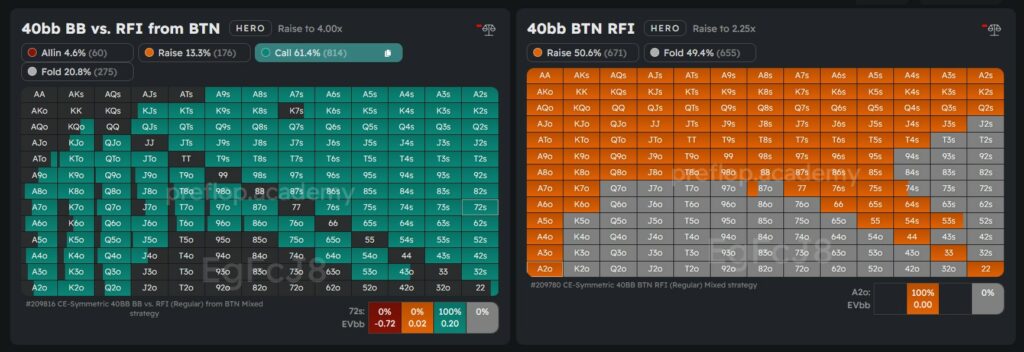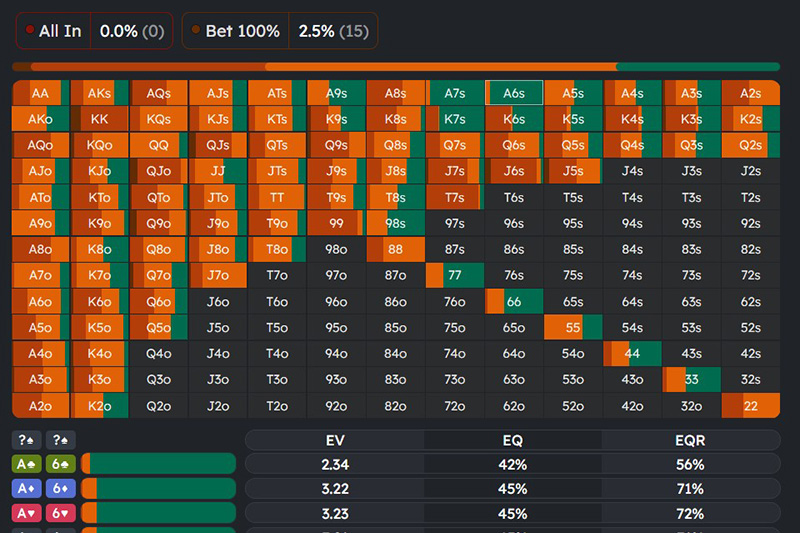If you’re a poker player, you’ve probably heard the term equity mentioned quite a few times. Equity is essential in poker since it is a crucial concept to understand for winning. But what exactly is equity realization in poker, and how does the equity realization factor affect your strategy? Let’s dive deeper into the topic and find out.
What is raw equity (EQ) in poker?
The equity of your hand, often referred to as your hand’s equity, plays a crucial role in guiding your decision-making process. It represents the statistical probability of your hand winning against your opponent’s range of possible hands if both players were to reveal their cards and reach a showdown.
Skilled players regularly estimate equity at every stage of a hand in poker. However, it’s important to note that this isn’t an infallible measure. Additionally, players often overemphasize the importance of equity and overlook Expected Value (EV), which is actually the most crucial indicator.
What will equity not tell us about?
Equity is a static measure. It doesn’t consider what might occur in the next phase of the hand. In many cases, players out of position tend to realize less equity due to the disadvantages they face. Another limitation of equity is that it doesn’t factor in the possibility of us or our opponents folding at any point in the game.
It’s important to understand the typical conclusion of a poker hand. Usually, someone places a bet, another player folds, and the hand concludes. If a fold happens at any point, equity becomes irrelevant. The player who folds ends up with 0% equity, and the winner takes 100% equity, which means they win the entire pot. This means that equity is not only a static value (omits future actions), but also a hypothetical one (if we were to reveal the cards and proceed to showdown).
What is Equity Realization?
Equity realization is a crucial concept in poker that refers to the percentage of the pot a hand can expect to win based on its raw equity and postflop variables. Unlike raw equity, which is a static measure of a hand’s potential to win at showdown, equity realization takes into account the dynamic nature of poker. It considers factors such as the opponent’s range, position, and postflop play. Essentially, equity realization helps players understand how much of the pot they can realistically expect to win, given the various elements at play during a hand.
What you need to know about equity realization factor?
Equity realization is the projected percentage of the pot a hand anticipates winning, taking into account its equity and the numerous postflop variables in play.
There’s a significant difference between a hand’s equity and how well that hand will perform if you continue in the pot. Let’s look at an example.

We defended the Big Blind (BB) with K8o. The flop came out as 772. After our check, the opponent played a continuation bet (C-bet). Despite our hand having a substantial equity of 46%, we were compelled to fold. If the opponent bet with 53s, they did so with an equity of just 28% and we folded a way better hand. Understanding our opponent’s range could have helped us make a more informed decision.
What insights can we derive from this scenario:
- We’ve firsthand encountered the practical use of EQR. With a hand like K8o, our equity fluctuates between 42% and 47%. However, when an opponent places a bet, it becomes difficult to fully realize this equity. In fact, we were unable to utilize any of it, as technically we should have folded every time. As an out of position player, we faced additional challenges in realizing our equity.
- At the same time, the player holding a 53s can realize more than 180% of their equity due to the bet!
- The aforementioned demonstrates how EV, which is of utmost importance, and EQR hold greater significance than EQ itself.
- It’s important to highlight that, in the scenario we encounter here, each hand within the BTN player’s range reaps the benefits of the entire range’s vast equity advantage (58% vs 42%). The preflop raise by the opponent set the stage for this equity realization dynamic.
- Equity realization is influenced by various factors such as range equity comparison, stack sizes, position, and it’s about how often you can actually accrue your rightful share of the pot. Having a range advantage allows a player to play more aggressively and realize greater equity. Different hands and positions affect a player’s ability to realize equity during the game.

| EQR realization | Favorable conditions | Unfavorable conditions |
|---|---|---|
| Equity advantage | High | None |
| Polarisation advantage | High | None |
| Position advantage | IP | OOP |
| Skill advantage | High | None |
| Stack sizes | Deep | Shallow |
Factors Affecting Equity Realization
Several factors affect equity realization, including:
- Position: Being in position gives a player more control over the hand and allows them to make more informed decisions, leading to higher equity realization. When you act last, you have the advantage of seeing how your opponents play their hands, which can help you make better decisions and realize more equity.
- Opponent’s Range: The strength and composition of your opponent’s range significantly impact your hand’s equity realization. A stronger range can lead to more aggressive play, making it harder to realize your equity. Conversely, if your opponent has a weaker range, you may be able to realize more of your hand’s equity.
- Hand Playability: Some hands, such as suited connectors, are more likely to realize their equity because they have the potential to hit strong postflop hands like straights and flushes. In contrast, unconnected off-suit hands often struggle to realize their equity due to their limited postflop potential.
- Stack Depth: The stack-to-pot ratio (SPR) plays a crucial role in equity realization. Deeper stacks allow for more postflop maneuvering and can lead to higher equity realization. Shallow stacks, on the other hand, often result in more all-in situations where equity realization is less relevant.
- Skill Advantage: A player’s skill level can greatly influence equity realization. More skilled players are better at making informed decisions, reading their opponents, and exploiting weaknesses, which allows them to realize more equity from their hands.
Practical Applications of Equity Realization
Understanding equity realization has several practical applications in poker, including:
- Making Informed Decisions: By understanding how much equity a hand is likely to realize, players can make more informed decisions about whether to call, raise, or fold. This knowledge helps in avoiding situations where a hand has high raw equity but low equity realization.
- Maximizing Expected Value: Equity realization helps players maximize their expected value by identifying situations where they can expect to win more of the pot. By focusing on hands and scenarios where equity realization is high, players can increase their overall profitability.
- Identifying Opportunities: By analyzing equity realization, players can identify opportunities to exploit their opponents’ weaknesses. For example, if an opponent frequently folds to aggression, a player can use this tendency to realize more equity from their hands.
- Improving Table Image: Understanding equity realization can help players improve their table image by making more informed decisions and avoiding marginal situations. A player who consistently makes good decisions based on equity realization is likely to be perceived as a strong and competent player, which can influence how opponents play against them.
In conclusion, equity realization is a critical concept in poker that helps players make informed decisions, maximize their expected value, and identify opportunities to exploit their opponents’ weaknesses. By understanding the factors that affect equity realization, players can improve their game and increase their chances of winning.
Conclusion about equity realization
Now that you understand what equity is, how it can or cannot be realized, and the different conditions that constitute good or bad equity realization, you are better equipped to make more informed decisions during the game. By applying the above information, you can expect to see improvements in your game and greater success at the table.
